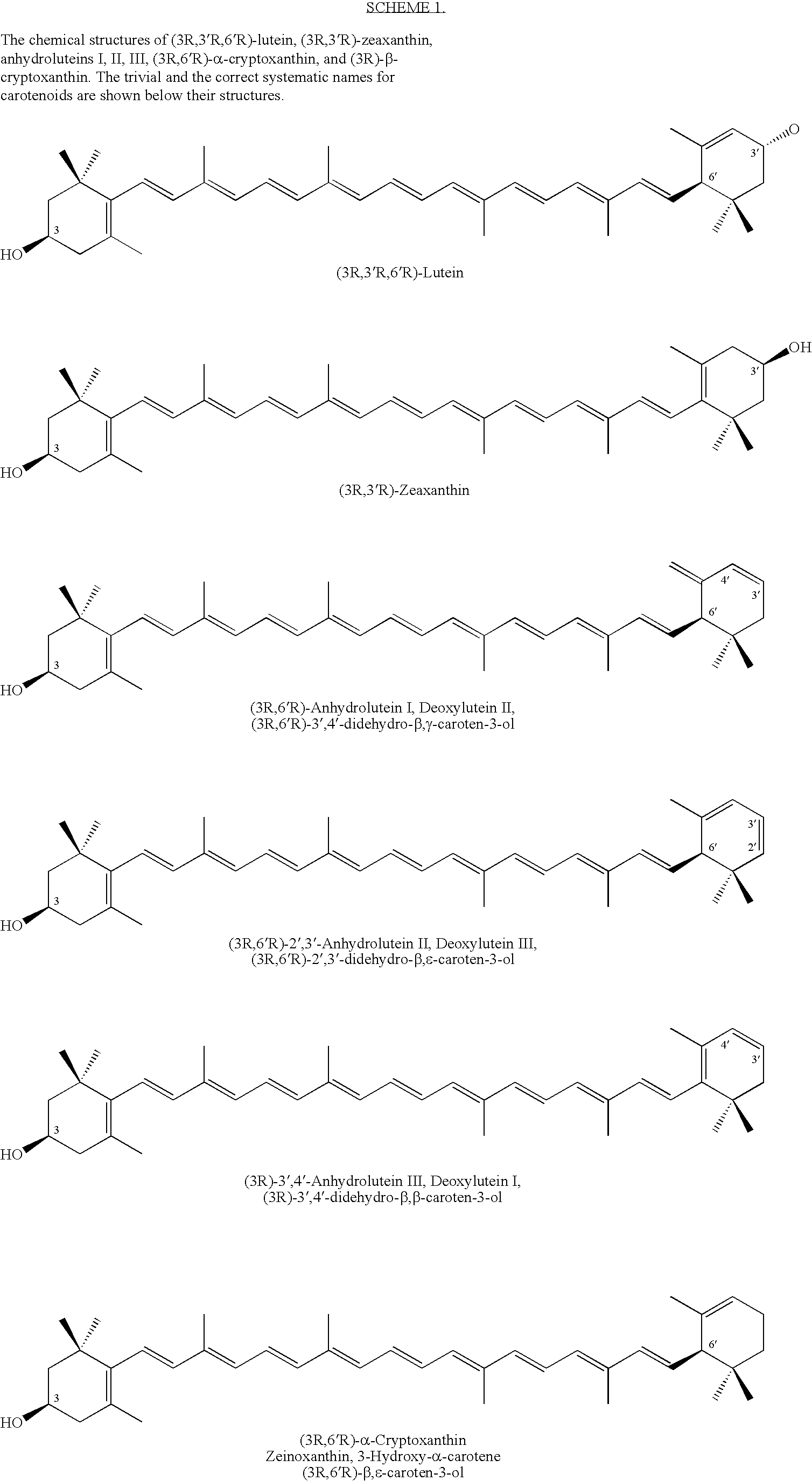Method for production of rare carotenoids from commercially available lutein
- Summary
- Abstract
- Description
- Claims
- Application Information
AI Technical Summary
Benefits of technology
Problems solved by technology
Method used
Image
Examples
example 1
Conversion of (3R,3′R,6′R)-Lutein (85%) to (3R,6′R)-α-Cryptoxanthin and (3R)-β-Cryptoxanthin with Trifluoroacetic Acid (TFA) and Triethylsilane (Et3SiH) in Dichloromethane
[0130]A solution of (3R,3′R,6′R)-lutein (0.300 g of 85% pure ≈0.255 g, 0.448 mmol)) in dichloromethane (25 ml) was first treated with triethylsilane (0.150 ml, 0.109 g, 0.94 mmol) followed by trifluoroacetic acid (0.12 ml, 0.178 g, 1.56 mmol). The mixture was stirred at ambient temperature under an atmosphere of nitrogen and the course of the reaction was followed by HPLC. After 8 h, the product was treated with 5% solution of sodium bicarbonate (15 ml) and stirred for 5 minutes. The mixture was distilled at atmospheric pressure by gradual displacement of dichloromethane (b.p.=40° C.) with 2-propanol (b.p.=82.4° C.). When nearly all of the dichloromethane was removed, the alcohol was distilled off under reduced pressure until carotenoids began to crystallize from aqueous alcohol. The mixture was allowed to cool dow...
example 2
Conversion of (3R,3′R,6′R)-Lutein (85%) to (3R,6′R)-α-Cryptoxanthin and (3R)-β-Cryptoxanthin with Trifluoroacetic Acid (TFA) and Triethylsilane (Et3SiH) in 1,2-Dichloroethane
[0131]A solution of (3R,3′R,6′R)-lutein (0.300 g of 85% pure ≈0.255 g, 0.448 mmol)) in 1,2-dichloroethane (25 ml) was first treated with triethylsilane (0.150 ml, 0.109 g, 0.94 mmol) followed by trifluoroacetic acid (0.12 ml, 0.178 g, 1.56 mmol). The mixture was stirred at ambient temperature under an atmosphere of nitrogen and the course of the reaction was followed by HPLC. After 8 h, the product was treated with 5% solution of sodium bicarbonate (15 ml) and stirred for 5 minutes. Most of 1,2-dichloromethane (b.p.=83° C.) was distilled under reduced pressure. 2-Propanol (20 ml) was added and distillation continued until carotenoids began to crystallize from aqueous alcohol. The mixture was allowed to cool down to room temperature and the crystals were removed by centrifugation. The aqueous layer was removed an...
example 3
Separation and Purification of Carotenoids from a Mixture of (3R,6′R)-α-Cryptoxanthin, (3R)-β-Cryptoxanthin, Anhydroluteins, and (3R,3′R)-Zeaxanthin by Column Chromatography
[0132]A flash column (20 cm 1×3.5 cm i.d.) was packed under slight pressure with n-silica gel (40 μm particle size) employing a mixture of hexane (90%) and acetone (10%). 0.3 g of a crude mixture of (3R,6′R)-α-cryptoxanthin, (3R)-β-cryptoxanthin, anhydroluteins, and (3R,3′R)-zeaxanthin obtained from reaction of (3R,3′R,6′R)-lutein with TFA / Et3SiH (example 1 or 2) was loaded onto the column using a 1 / 1 mixture of hexane and acetone. The mixture of carotenoids was eluted with hexane / acetone (9 / 1). Three major colored bands were collected. In the order of elution these were; 1) a pure mixture of (3R,6′R)-α-cryptoxanthin and (3R)-β-cryptoxanthin, 2) a mixture of anhydrolutein I, II, and III, and 3) (3R,3′R)-zeaxanthin. The solvents were evaporated under reduced pressure and the pure carotenoids were dried under high ...
PUM
| Property | Measurement | Unit |
|---|---|---|
| Temperature | aaaaa | aaaaa |
| Temperature | aaaaa | aaaaa |
| Temperature | aaaaa | aaaaa |
Abstract
Description
Claims
Application Information
 Login to View More
Login to View More - R&D
- Intellectual Property
- Life Sciences
- Materials
- Tech Scout
- Unparalleled Data Quality
- Higher Quality Content
- 60% Fewer Hallucinations
Browse by: Latest US Patents, China's latest patents, Technical Efficacy Thesaurus, Application Domain, Technology Topic, Popular Technical Reports.
© 2025 PatSnap. All rights reserved.Legal|Privacy policy|Modern Slavery Act Transparency Statement|Sitemap|About US| Contact US: help@patsnap.com



